Ohio
| |
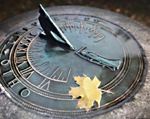 |
Athens |
Ohio |
USA |
Horizontal Dial |
Dial 1009 |
| For a dial 114 years old, it is in excellent condition. The bronze dial is of simple form with hour marks every quarter of the hour and a chapter ring with Roman hours from 5:30am to 6:30pm. Surrounding the chapter ring it reads "Ohio University". Father time stands with a scythe at the foot of the gnomon that contains the profile of a bird. On the dial plate Shakespeare's Sonnet 16 is lightly engraved. The sundial was erected in 1907, though there is a photo of "a quartet of gentlemen" attributed in 1890, yet the cylindrical pedestal with plaque is easily recognizable. |
| |
| |
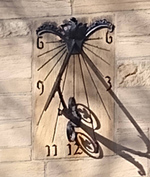 |
Boardman |
Ohio |
USA |
Vertical Dial |
Dial 1031 |
| This vertical dial fits well with the gothic style of the memorial chapel. The sundial gnomon and its fittings appear to be cast bronze, appropriately ornate and quite beautiful. Arabic numerals are chiseled into the stone wall, marking the hours of 6, 9, 11, 12, 1, 3 and 6. Other hour lines are unlabeled. |
| |
| |
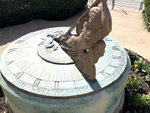 |
Cincinati |
Ohio |
USA |
Horizontal Dial |
Dial 1141 |
| This is a 5 foot (1.5m) diameter, bronze horizontal dial sitting on a limestone plinth. The dial tells time from V – XII – VII in 15 minute increments. Underneath the style of the gnomon in relief is a sculpture of Hygieia, goddess of health, cleanliness and hygiene. She is emerging from a snake that wraps around the dial face, representing the medical profession. |
| |
| |
 |
Cincinati |
Ohio |
USA |
Alignment |
Dial 1140 |
| The alignment ring of seven sculptures indicates the time of solar noon and date of the solstices and equinoxes. The sculpture is titled “Seven Vessels Ascending/Descending”. The alignment of the seven sculptures is on a 40 feet (12m) circle of grass surrounded by a circular red brick plaza.. In the very center of the circles is a 2-foot (.6m) diameter marble slab indicating the direction of sunrise/sunset on the solstices and equinoxes. It also indicates the N-S meridian line and time of solar noon on the solstices. |
| |
| |
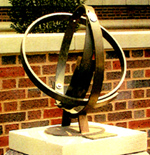 |
Cincinnati |
Ohio |
USA |
Armillary Sphere |
Dial 26 |
| This is an unusual armillary sphere without the standard gnomon rod, allowing the dial to be adjusted easily to tell civil time. As generally expected of an armillary or equatorial sundial, there is an equatorial time ring (16 inches in diameter) with engraved hourly time marks fastened to a meridian ring. But for this dial the equatorial and meridian ring assembly rotates on a polar axis. The dial functions as a Pilkington & Gibbs Heliochronometer: A small hole with lens where the equatorial and meridian rings meet allows a focused spot of sunlight to fall upon the opposite side of the rings where there is a plaque engraved with an analemma and associated monthly and day marks along the curve. This assembly is an analemmic alidade, allowing the user to align the spot of sun to an offset along the analemma curve of date that adjusting the sundial for the equation of time and longitude off time zone meridian. Civil time is read on the equatorial ring from a marker located on a fixed meridian. Knowing the month and approximate day, the dial can be read to the nearest minute. |
| |
| |
 |
Cincinnati |
Ohio |
USA |
Analemmatic Dial |
Dial 993 |
| This analemmatic sundial is laid out in brick. The walkway consists of an inlaid brass analemma surrounded by month indicators for where to stand etched in brick. The analemmatic ellipse is brass, etched with time marks every 15 minutes. Just to the inside and outside of the ellipse are the hours in standard and daylight savings time. Brass indicators are inlaid for the Bailey Points to show the of time and direction of sunrise and sunset. At the edge of the circular brick plaza are granite markers of the cardinal points. |
| |
| |
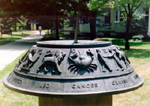 |
Cleveland |
Ohio |
USA |
Horizontal Dial |
Dial 270 |
| Horizontal dial 2 ft (0.6m) in diameter with a sloping circumference to increase the size of the to nearly 3 ft (1m). The sloping circumference is a flaring flange decorated with the 12 signs of the zodiac. Dial rests on an octagonal stone pillar.and base. |
| |
| |
|
Cleveland |
Ohio |
USA |
Armillary Sphere |
Dial 285 |
| In 2014, Cleveland Botanical Garden joined forces with The Holden Arboretum to become Holden Forests and Gardens. The dial is a 37 inch diameter armillary. Composed of four iron rings bisected by an arrow. Mounted atop an upright cylinder. Gift of Lucile Teeter Kissach. Restored 1993. |
| |
| |
|
Cleveland |
Ohio |
USA |
Horizontal Dial |
Dial 405 |
| A ground level horizontal dial 14 feet in diameter, with gnomon 5 ft 3 inches high. The dial is made of concrete, brick, and granite. |
| |
| |
 |
Cleveland |
Ohio |
USA |
Horizontal Dial |
Dial 619 |
| A 7 fft (2.1m) diameter semicircular inclined horizontal dial of concrete with a bronze gnomon. The gnomon support features a cast representation of a nautilus shell. Each hour arc is marked with a geologic period within the "542 million year period" most animal life has evolved. |
| |
| |
 |
Clifton Village |
Ohio |
USA |
Vertical Dial |
Dial 610 |
| A 35 x 23 inch vertical acrylic painted wood dial. Dial face includes longitude-corrected hour lines with Roman numerals, noon analemma, and equinox and zodiacal declination arcs. The dial is designed for a declination of 1° 18' West of South. Dial nomenclature includes location, declination and time zone offset. |
| |
| |
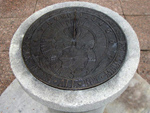 |
Columbus |
Ohio |
USA |
Horizontal Dial |
Dial 946 |
| This brass dial is a replica of the sundial installed at Mt. Vernon. It is about 12 inches in diameter with an offset eight point compass rose. The chapter ring has hour marks from 5am to 7pm in Arabic numerals. Hours are divided into quarter hours. Unfortunately the gnomon is broken off leaving only the lower third. |
| |
| |
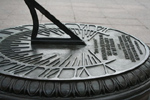 |
Columbus |
Ohio |
USA |
Horizontal Dial |
Dial 947 |
| This is one of a series of bronze sundials presented by Daughters of Union Veterans of the Civil War, dedicated to the memory of the Grand Army of the Republic. This dial is 24 inches in diameter, with an ornate design of ovals at the exterior, sloping down to 30 inches in diameter. Hours are marked from 5am to 7pm in Roman numerals. Time is marked in quarter hours. The gnomon is a simple open triangle. |
| |
| |
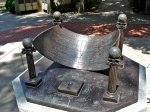 |
Columbus |
Ohio |
USA |
Cylindrical Dial |
Dial 681 |
| A cast bronze equatorial dial with inscribed analemma EOT figures on each hour line. Equatorial ring is a spherical segment. Arabic numerals mark Standard Time. Gnomon is missing. Dial sits atop a fluted Roman column on square base. |
| |
| |
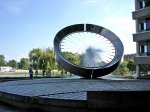 |
Columbus |
Ohio |
USA |
Sculpture/Artwork |
Dial 357 |
| "Hora Novem" An unusual 'solar calendar water sculpture' incorporating water jets which converge at center of a 17ft equatorial ring. |
| |
| |
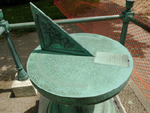 |
Dayton |
Ohio |
USA |
Horizontal Dial |
Dial 102 |
| A circular granite dial about 2 feet (.75cm) in diameter. It has an ornate, very large triangular gnomon of brass decorated with flowers. The dial sits on a sculpted column with spreading base. Protected by brass railing that surrounds the dial. The dial was erected in 1896 to celebrate Dayton's centennial. The dial was moved from its former location on Monument Avenue (originally called Main Street) in front of Newcom Tavern and relocated during ceremonies marking the moving of Newcom Tavern to Carillon Park on May 1, 1965. |
| |
| |
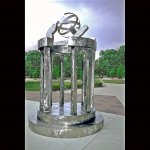 |
Delaware |
Ohio |
USA |
Armillary Sphere |
Dial 595 |
| A 24 inch diameter stainless steel armillary dial with equator, meridian and horizon rings. The armillary includes compass points and zodiacal symbols. The dial sits atop a 6 foot tall architectural sculpture of four two-columned arches also made of formed and welded stainless steel sheet with a random polished pattern creating dark and bright areas that change as the sun moves across the work. The armillary is held by fingers of a sculpted hand, representative of works by the designer, Alvin Sher, and symbolizing mankind, creativity, knowledge, peace and greeting as well as identity among many other human meanings. The dial sits atop a six foot tall stainless steel architectural sculpture with four pairs of columns with a supporting arch between each pair. The entire sculpture is made of textured and welded sheet up to 3/16 inch thick. |
| |
| |
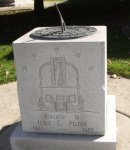 |
Delphos |
Ohio |
USA |
Horizontal Dial |
Dial 548 |
| A horizontal dial on a stone block. Dedicated to Leslie C. Peltier, recognized as "World's greatest non-professional astronomer" by Harvard Observatory. Dial sits atop a stone block, possibly marble. |
| |
| |
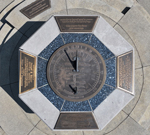 |
Fairfield |
Ohio |
USA |
Horizontal Dial |
Dial 1124 |
| A compound bronze horizontal dial approximately 24in (61cm) in diameter with a second meridian transit gnomon hole to cast a beam of light onto a noon analemma. The outer chapter ring shows Standard Time with Roman numerals, 1 hour marks. The inner chapter ring show Daylight Savings Time in Arabic numerals with 15 minute marks. Note that like most horizontal dials standard/daylight time is local solar time, measuring time as it crosses the meridian. The noon analemma uses holidays and seasons as date marks. The analemma is offset from the dial's N-S meridian, showing the sun's illumination on the analemma curve using local Daylight Savings Time. Fairfield Ohio, even at 84° W is on Eastern Time, such that to tell civil time, one needs to add 38 minutes to shadow time. If one looks at the plaque that contains a graph of the Equation of Time, that 38 minutes is included. Both the offset noon meridian dial and EoT graph result in precise civil time. The whole complex is an octagon about 5 ft (1.5m) across. |
| |
| |
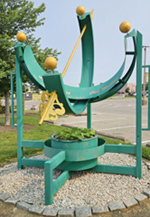 |
Fairfield |
Ohio |
USA |
Equatorial Dial |
Dial 1126 |
| This is a 10-foot (3m) equatorial sundial made of steel and painted green. Gold painted balls are located on the ends of the meridian and equatorial arcs. Following tradition, the gnomon is a rod with a decorative arrow and tail painted gold. The base includes a decorated plat holder with eight compass points and azimuth degrees marked in 10 degree increments and labeled every 30 deg. Both Roman numerals mark the hours from 6am to 6pm. Arabic numerals mark every third hour. The numerals and other details are vinyl graphics in gold and red. |
| |
| |
 |
Georgetown |
Ohio |
USA |
Horizontal Dial |
Dial 1110 |
| This is a large commercial bronze horizontal dial set at ground level on a circular concrete pad. The dial is embossed with Roman hours in a chapter ring and delineated for quarter hours. The inscription circles the dial in an outer rim. The gnomon is standard with a bird beneath the style. However the gnomon is set about 2 inches (5cm) north of the VI-VI line. It may not matter as the dial appears to be under a tree. |
| |
| |
 |
Granville |
Ohio |
USA |
Horizontal Dial |
Dial 528 |
| This horizontal sundial is built on a one-meter cube of red granite with a cast bronze gnomon supported by a cast bronze Pegasus modeled by New York artist Carl Paul Jennewein. The dial's plaza location overlooks the village of Granville and the valley beyond to the south. The dial is a tribute to Clifford S. Stilwell (Denison Class of 1912) who was Chairman of the Denison Board of Trustees at his death in 1941. The early B&W photograph of the Pegasus gnomon is courtesy of Denison University Archives. |
| |
| |
 |
Hamilton |
Ohio |
USA |
Horizontal Dial |
Dial 1109 |
| This is one of a series of bronze sundials presented by Daughters of Union Veterans of the Civil War, dedicated to the memory of the Grand Army of the Republic. The dial is 24 inches in diameter, with an ornate design of ovals at the exterior, sloping down to 30 inches in diameter. Hours are marked from 5am to 7pm in Roman numerals with time marked in quarter hours. The dial base is open bronze work held by four pillars sitting on a circular bronze base. Through the efforts of Kathleen Stuckey Fox and the citizens of Hamilton, OH, the dial and surrounds of Monument Park have undergone significant restoration. Hawkins & Hawkins, LLC of Cincinnati expertly cleaned and refinished the Hamilton GAR dial. Since the original gnomon was missing, they also designed, cast, and welded into place a new bronze gnomon. |
| |
| |
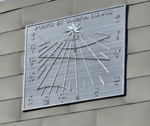 |
Liberty Township |
Ohio |
USA |
Vertical Dial |
Dial 1142 |
| A stainless steel, vertical south facing dial, declining 15 degrees to the west. The dial is approximately a 6.5 feet (2m) square. Hours are measured VII – XII – V in winter and 8 – 12 – 6 in the summer, telling time in increments of the half-hours. Equinox, summer and winter solstice lines are shown. The gnomon originates from a sun motif with a hole for nodus to indicate the season. |
| |
| |
 |
Logan |
Ohio |
USA |
Analemmatic Dial |
Dial 982 |
| An analemmatic dial set in a gravel rectangle. It has a concrete walkway and circular hour markers in two ellipses for standard and daylight time. The hour numbers are adjusted for longitude, shifting them by 30 minutes (such that the due north line reads 12:30). |
| |
| |
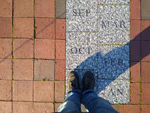 |
Montville |
Ohio |
USA |
Analemmatic Dial |
Dial 1034 |
| The zodiac walkway is made from 12 granite paving blocks engraved with abbreviated names of the months of the year. A nearby plaque instructs the observer to stand on the appropriate block to tell the time with one's own shadow. Time is indicated on inconspicuous bricks with black Arabic numerals. The hours are adjusted for longitude and set for Daylight Saving Times |
| |
| |
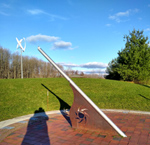 |
Montville |
Ohio |
USA |
Horizontal Dial |
Dial 1035 |
| The sundial gnomon is a metal pole about 4 inches (10 cm) diameter and 15 feet (4.5 m) long. Arabic numerals are engrave into stone paving blocks set on the perimeter of a 30 foot (9 m) circular brick plaza. The hour numbers are offset for both site longitude and daylight saving time. The gnomon is held metal work with a large sunburst in the center. |
| |
| |
|
Newark |
Ohio |
USA |
Analemmatic Dial |
Dial 460 |
| An analemmatic dial with stone markers for the hours |
| |
| |
 |
Oberlin |
Ohio |
USA |
Vertical Dial |
Dial 219 |
| Once, high on the physics building south wall was a student made vertical dial. The 5'x8.5' resin coated particle board made by Mark Kearns in 1979 had curved hour lines to account for the equation of time, declination of wall, and offset from standard meridian. This dial has not been on display for some time. Perhaps some student would create a new dial. The brick wall is an excellent location. |
| |
| |
 |
Oberlin |
Ohio |
USA |
Sun Alignment |
Dial 63 |
| When is a flag pole more than a flag pole? When it has cement walkway curved for the summer solstice, a path for the winter solstice and a distinguishing straight cement line for the spring and fall equinox. This dial has no hour markers, and is intended to show the seasons. The tip of the flag pole will follow these lines at the appropriate day of the season. |
| |
| |
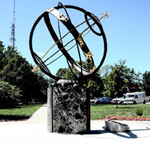 |
Oxford |
Ohio |
USA |
Armillary Sphere |
Dial 103 |
| A 6 foot armillary sphere sitting on a marble column supported by a ring of turtles. The armillary has equatorial, meridian, polar and equatorial rings, plus the arctic and antarctic rings near the poles. Along the outside of the equatorial ring are golden figures, marking the houses of the zodiac. On the inside of the equatorial ring are Roman numerals marking the hours. The armillary was a gift to the university on its 50th anniversary by the Miami chapter of Delta Delta Delta sorority. The plaque given coordinates of latitude and longitude of the dial that are slightly different than those from Google Earth, which are the coordinates given here. |
| |
| |
 |
Parma |
Ohio |
USA |
Armillary Sphere |
Dial 580 |
| A three foot armillary sundial with equatorial ring and gnomon pointer on a stone base with dedication plaque. Dial was built by the local high school vocational welding class in 1988. |
| |
| |
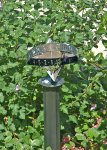 |
Toledo |
Ohio |
USA |
Equatorial Dial |
Dial 621 |
| An equatorial projection dial 18 inches wide atop a 3 foot high fluted steel column. Located on the Anthony Wayne Trail Bridge inside the zoo near its entrance, access requires zoo admission. Dial sits atop a three foot high fluted steel column. |
| |
| |
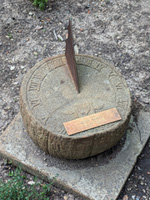 |
Westerville |
Ohio |
USA |
Horizontal Dial |
Dial 1102 |
| This horizontal dial is of weathered concrete, about 38cm (15 inches) in diameter. Roman numerals mark the hours from 5am to 7pm. A large bronze gnomon with foot in the center of the round dial casts the shadow. The north edge of the gnomon is shaped into a face. The garden includes a traditional knot garden, a water feature, and a unique sundial made of herbs. |
| |
| |
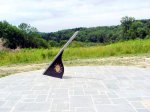 |
Wilmot |
Ohio |
USA |
Horizontal Dial |
Dial 444 |
| The Wilderness Center Sundial is large horizontal dial with a 6-foot steel gnomon approximately 27 inches thick. The base is done in slate with copper numbers. |
| |
| |
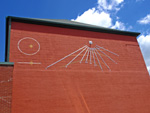 |
Wooster |
Ohio |
USA |
Vertical Dial |
Dial 799 |
| A vertical dial on a 15 x 40 foot section of a second story brick wall declining 11° east. The gnomon, hour lines and 7 am to 4 pm Arabic hour numerals are aluminum. |
| |
| |
|
Wooster |
Ohio |
USA |
Horizontal Dial |
Dial 196 |
| Brass or bronze Gift to the College from the Class of 1907. On S side of gnomon, an embossed figure, possibly Father Time with scythe. Mounted atop a carved stope base with motto, "United in time, parted in time to be reunited when time shall be no more." |
| |
| |
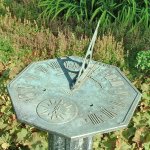 |
Yellow Springs |
Ohio |
USA |
Horizontal Dial |
Dial 628 |
| A 14.5 inch octagonal bronze horizontal dial on a cast iron pedestal. Dial was originally made for the present owner's great grandfather in the early 1900's. Face has Roman numerals with hour and half-hour markers. Compass rose cast in face aligns to magnetic north and stars of Big Dipper are shown. Dial was made originally for location near Northampton, Pennsylvania in early 1900's and is marked "41° LATITUDE." At present location, dial is tipped 1.2° for latitude correction. Two time arcs are shown on the dial face: "LONG DAY" arc extends from 5 AM to 7 PM; "SHORT DAY" arc extends from 7:30 AM to 4:30 PM. |
| |
| |
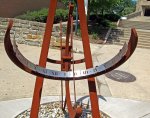 |
Youngstown |
Ohio |
USA |
Equatorial Dial |
Dial 720 |
| A nearly 10 foot high steel equatorial dial with a 30 inch diameter stainless steel hour ring including cut-out diamonds for hour and half-hour marks and Roman hour numerals. The hour ring can be adjusted for EST or EDST and can be set to include longitude correction. The mild steel sculpture has naturally weathered.
Located outside the YSU Ward Beecher Planetarium, the dial is dedicated to the memory of Richard Pirko, long-time planetarium engineer and show producer, whose dream was to have a sundial outside the planetarium. A nearby bronze plaque dedicates the dial. |
| |
| |
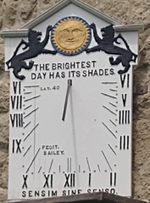 |
Youngstown |
Ohio |
USA |
Vertical Dial |
Dial 1033 |
| Since the wall of the house/museum does not face true south, this vertical dial is set atop a plinth mounted midway up the south-west wall. The 2 x 4 foot (61 x 122 cm) dial face appears to be painted white wood ornamented with a gold face of the sun held by two black heraldic lions. The gnomon is a simple rod and the dial is delineated for due south with "Lat 40°" painted on the dial face. However, the building is at 41° latitude. Along the periphery of the dial face painted in black are hours are marked in Roman numerals from VI to VI with lines showing hour lines and shorter lines for the half-hours. Quarter hours are marked with black dots. The sundial was restored within the past ten years. |
| |